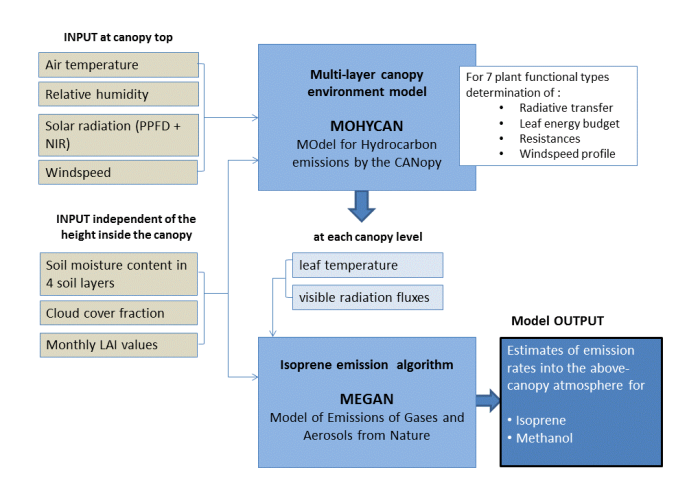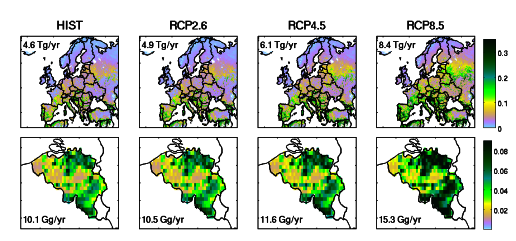You are here: Cordex.be » Simulations » Local-Impact Models » MEGAN-MOHYCAN
Isoprene or vegetation emission model: MEGAN-MOHYCAN
The MEGAN-MOHYCAN model enables the calculation of fluxes emitted by the vegetation. It couples two sub-models, namely the Model of Emissions of Gases and Aerosols from Nature (MEGAN, Guenther et al. 2006), and the MOdel of HYdrocarbon Emissions from the CANopy (MOHYCAN, Muller et al. 2008), which has been developed at BIRA-IASB in collaboration with NCAR (see figure below).
MEGAN is the most widely used emission model for hydrocarbon emissions from the biosphere. It incorporates a large number of available flux measurements and uses the distribution of basal emission rates. Activity factors account for the response of the emission to leaf-level temperature and solar radiation, as well as leaf age, soil moisture, and the leaf area index. Leaf temperature and light attenuation by the canopy are calculated by the MOHYCAN canopy environment model, as a function of the height in the canopy, using visible and near-infrared solar radiation values at the canopy top, together with air temperature, relative humidity, wind speed and cloud cover. This is realized by (i) estimating the direct and diffuse fractions of solar radiation at each of the eight MOHYCAN canopy levels using a radiative transfer model, (ii) determining leaf temperature iteratively using the energy balance equations by including the determination of resistances for the exchange of heat and water vapour between the air and the leaves, and accounting for attenuation of the wind speed by the foliage.

In the CORDEX.be project the estimated biogenic emissions, based on the MEGAN-MOHYCAN model, are correlated with the temperature and the downward solar radiation; which are both provided by the CORDEX.be high-resolution simulations. The emitted species (isoprene, terpenes, etc.) are highly reactive and known to enhance tropospheric ozone formation in polluted conditions causing adverse effects on human health and vegetation. A future increase in temperature and/or solar radiation is expected to lead to larger biogenic emissions, and therefore to higher ozone concentrations. As an illustration, the figure below shows how present day isoprene emissions (HIST) could increase in the future (2077-2099) according to different climate projection scenarios provided by the ALARO-0 regional model.

Spatial distribution of isoprene emissions for present day conditions (HIST) as well as future (2077-2099) RCP climate projection scenarios provided by the ALARO-0 regional model.
